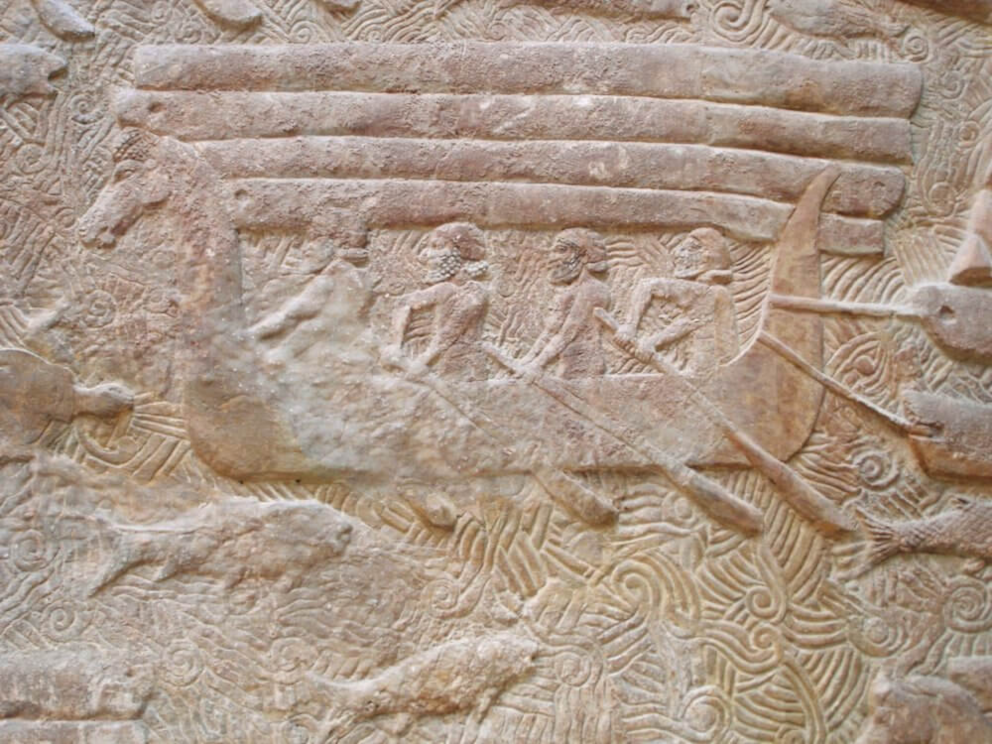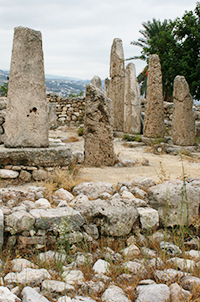
Not a Friend of ASOR yet? Sign up here to receive ANE Today in your inbox weekly!

September 2023
Vol. 11, No. 9
Maritime Viewscapes and the Material Religion of Levantine Seafarers
By Aaron Brody
For ancient peoples, travel was profoundly liminal. Voyaging at sea was doubly liminal, leaving the safety of land and existing in a state of in-betweenness on the waters. To mitigate these thresholds, Levantine seafarers developed specialized religious ideas and practices not shared by their counterparts who never left dry land.
Two types of deities were vital for mariners, ones whose attributes controlled storms and others that affected wayfinding. In the Levantine pantheon, the storm god, Ba‘al, was a patron of seafarers. Marine deities, such as the Phoenician “Poseidon”, also had tutelary relationships (Figure 1). The goddesses Asherah and Tanit played vital roles in the protection of navigation, perhaps because of their link to the new, crescent moon (Figure 2). The god Melqart’s importance to seafarers is verified by numerous data, perhaps as a patron of commerce or voyaging.
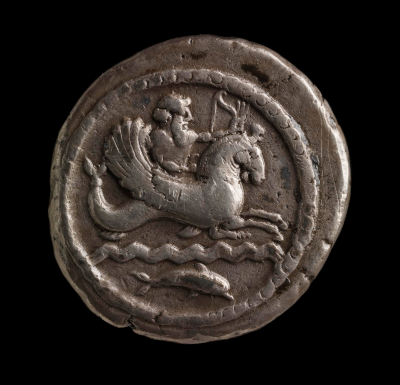
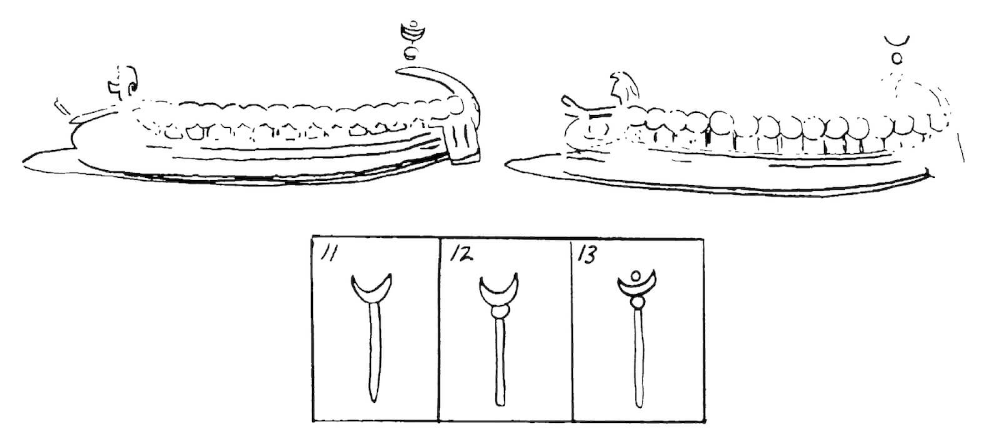
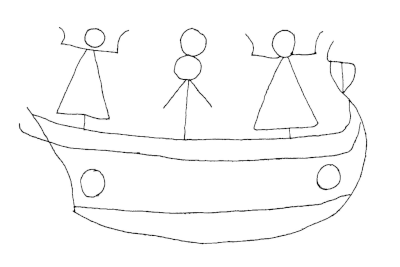
Fig. 3: Signs of Tanit and caduceus on ship’s standards from a sacrificial stele, Carthage. Source: Brody 1998, Fig. 16.
Seafarers gave propitiations at harbor temples to honor their divine patrons, some unique to the sailors’ world. Votives included objects fashioned for rituals such as model ships, miniature rudders, and nautical graffiti, and ritualized artifacts such as anchors, anchor stocks, and steering oars. This is verified by nautical finds from temples at Byblos, Ugarit, Tell Sukas, and Kition-Bamboula, as well as Coria del Río and Carambolo in Spain. Temples in harbor cities may have also served as navigational aids while on the water.

Fig. 4: Smiting god on prow of Phoenician warship, tomb painting, Kef el Blida. Source: Brody 1998, Fig. 24.
While voyaging away from port, promontory shrines were visible to sailors and continued the link with their divine patrons. Classical authors detail numerous Phoenician promontory shrines. Excavated examples from various periods are found at Nahariyah, Ashkelon, Mevorakh, Makmish, Tell Sukas, Kommos, Capo San Marco at Tharros, Kition, and Ras ed-Drek. The island of Malta had at least four, protecting seafarers during varied approaches to the island.
In ancient and modern traditional seafaring cultures, ships are considered imbued with divine spirits. This belief is manifested in representations of a deity placed on board vessels or at their prows; oculi, or eyes, included at prows; and ships named after a deity (Figures 2–5). These spirits and other divinities were worshipped at sacred spaces on board, typically located at the prow or stern of vessels. A goddess figurine was found in the prow of the Uluburun wreck. A Phoenician wreck at Bajo de la Campana included a single stone altar. Iconography and texts detail Phoenician horse-headed vessels (Figure 6), and god and goddess prow figures (Figures 2, 4, 5).
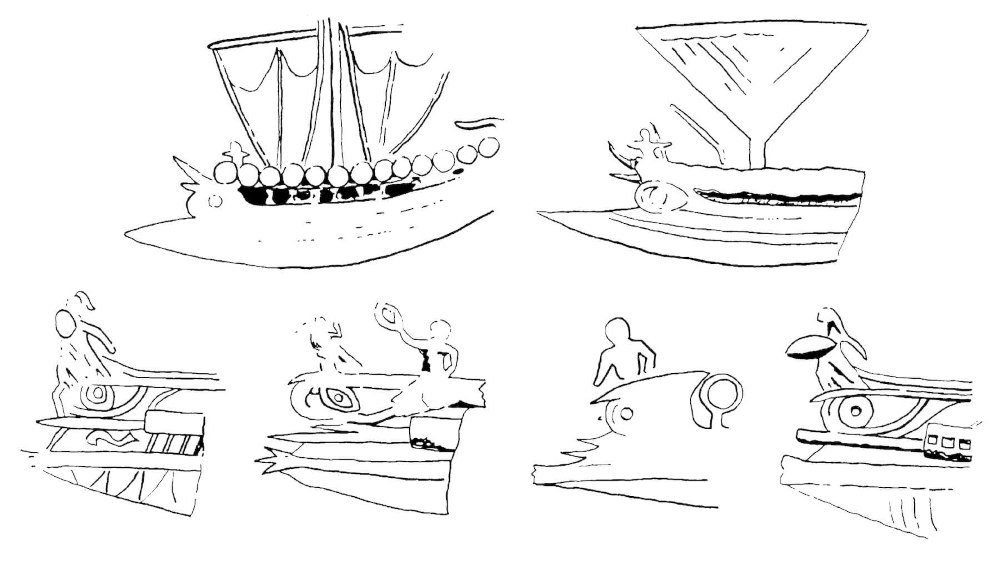
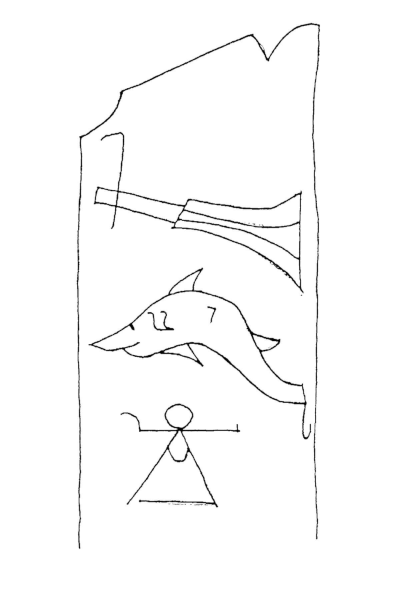
Fig. 7: Ship’s rudder, dolphin, and sign of Tanit; sacrificial stela, Carthage. Source: Brody 1998, Fig. 20.
Various divine symbols adorned ships (Figures 2, 3, 5). These included the caduceus, crescent, crescent-and-disk, and the sign of Tanit (Figures 2–3), all emblems of the goddess Tanit. Ships’ eyes are very common in representations of ships (Figures 2, 4). Depictions of vessels’ prows or sterns, rudders, and anchors on Carthaginian sacrificial stelae further suggest the sacral significance of different locations on board and ships’ equipment (Figure 7).
Levantine sailors performed religious ceremonies to please divine patrons, ensure safety during a voyage, and aid in proper navigation. According to classical authors, Phoenician seafarers made sacrifices to Melqart before setting sail and after landing in harbor. Offerings of stone anchors, anchor stocks, and model ships demonstrate that celebrations took place and vows were fulfilled in coastal sanctuaries dedicated to various divine patrons.
Evidence of prayers taking place on board is found in a painting from the tomb of Kenamun that depicts a convoy of Levantine ships mooring in Egypt (Figure 8a, 8b). Some of the crew hold their hands up in prayer, others burn incense and offer libations. Artifactual evidence includes incense burners uncovered on several Phoenician shipwrecks.
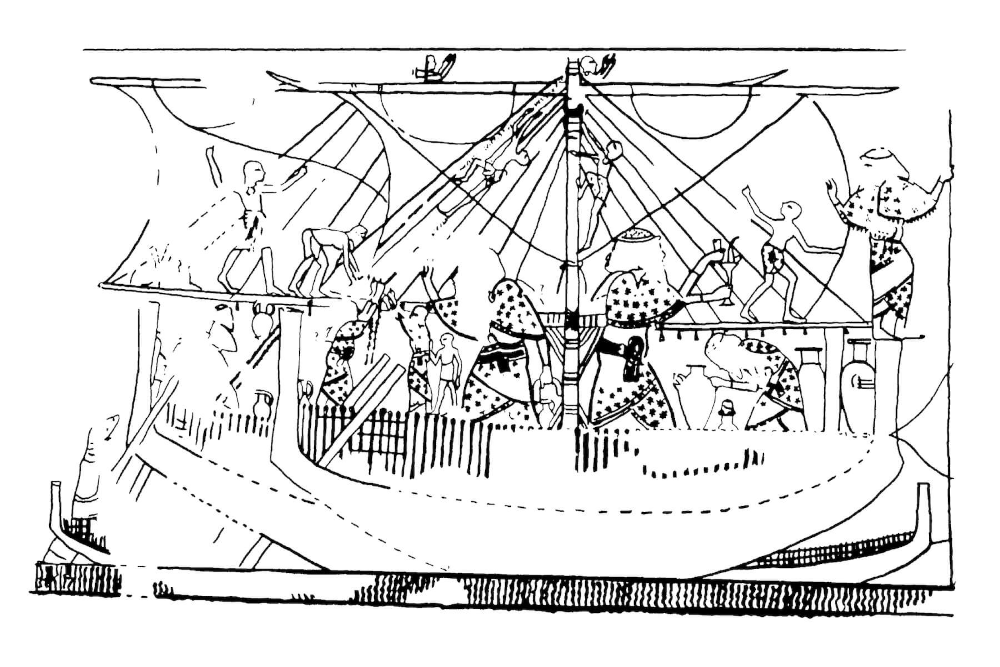
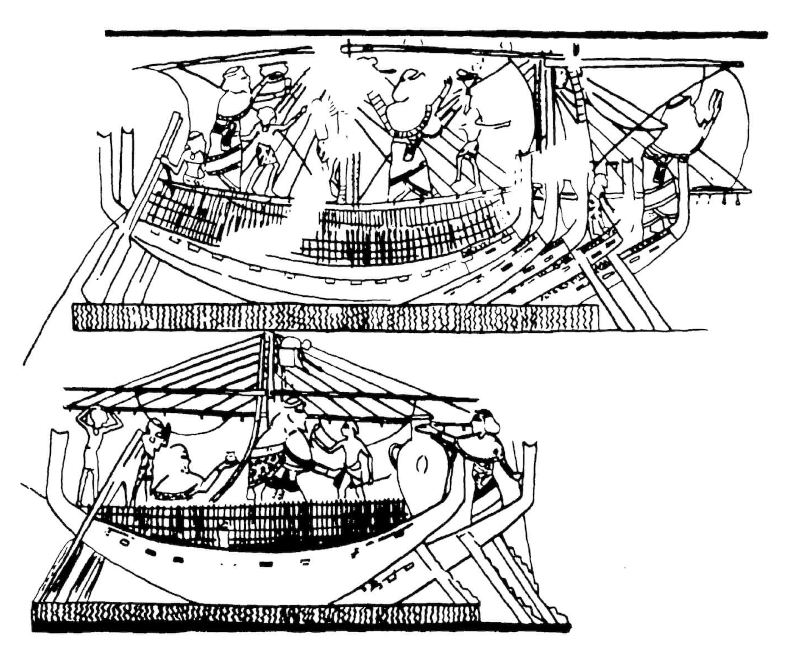
While facing perils at sea, mariners made vows to their divine guardians to solicit sacred protection. These are detailed in stories of the fabled Phoenician prince, Cadmus, and the Book of Jonah. It is not surprising that forecasts, also, were essential for the safety of a voyage. A bad omen from a sacrifice to Melqart was enough to turn around an expedition from Carthage; a soothsayer accompanied a colonizing voyage along the Atlantic shore of Africa; and lots are thrown on Jonah’s voyage.
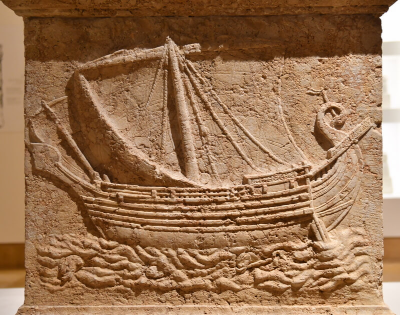
Fig. 9: Depiction of a ship on a 2nd-century sarcophagus from Sidon. Beirut National Museum. Photo: Public Domain; CC0 1.0).
Many perished at sea. The only detailed mourning rites of Phoenician mariners are found in Ezekiel 27, which indicates that mortuary rituals were not performed aboard ship, which may represent a taboo common among traditional seafarers. Some tombs from the harbor sites of Byblos, Ugarit, Ashkelon, and Tel Akko include stone anchors left as offerings. Later Phoenician burials sometimes contain model ships, and several Phoenician tombs have the depiction or graffiti of ships on their walls (Figure 9). These familiar maritime votives may have been a final tribute to a mariner’s divine patron.
The evidence presented elucidates the specialized religious beliefs and ritual practices of Levantine seafarers. Relationships were maintained with deities that controlled storms and wayfinding across double liminal waters, including Ba’al, Asherah, Tanit, Phoenician Poseidon, and Melqart. These divine patrons were worshipped in harbor temples before setting sail, and upon safe arrival in port, sometimes with specialized offerings such as stone anchors, anchor stocks, or model ships. While at sea, the vessels themselves and their deities protected sailors. Sacred spaces were maintained aboard ships, and divine mountains, headlands, and promontory shrines allowed for viewscapes that perpetuated sacral links and aided successful navigation. At night, wayfinding followed the movement of divinized stars, planets, and constellations. Ceremonies were performed at various thresholds within a voyage and when disasters were averted, vows were fulfilled in harbor temples. When ships sank or death occurred at sea, special mortuary rituals took place on land, and maritime symbols accompanied some sailors to their graves. Conceptualizing the religion of seafarers allows us to connect and expand on the crucial importance of maritime technology and trade to Levantine cultures that pioneered exploration, commerce, and fishing throughout the Mediterranean and Atlantic shores of the Iberian peninsula and northwestern Africa.
Aaron Brody is Robert and Kathryn Riddell Professor of Bible and Archaeology and Director of the Bade Museum of Biblical Archaeology at the Pacific School of Religion.
Want to learn more? Professor Brody will be giving a webinar for the Friends of ASOR on this topic on October 5. Register Here!
Further Reading
Brody, A.J. 1998. “Each Man Cried Out to His God,” The Specialized Religion of Canaanite and Phoenician Seafarers. Atlanta: Scholars Press.
Brody, A.J. 2021. “Sail, Pray, Steer: Aspects of the Sacred Beliefs and Ritual Practices of Phoenician Seafarers.” Advances in Ancient Biblical and Near Eastern Research 1/2: 1-30.
Brody, A.J. 2023. “Maritime Viewscapes and the Material Religion of Levantine Seafarers.” Pp. 399-412 in Handbook of Material Religion in the Ancient Near East, eds. N. Laneri and S.R. Steadman. London: Bloomsbury Academic.
Want To Learn More?
Were There Phoenicians?
By Josephine Quinn
The ancient Phoenicians traveled the Mediterranean and beyond as navigators and colonists. But what did they call themselves? In their own eyes, Phoenicians don’t seem to have existed. Read more
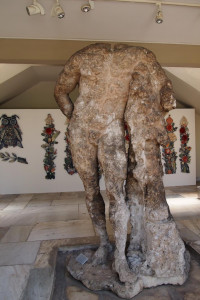
The Maritime Transport of Sculptures in the Ancient Mediterranean
By Katerina Velentza
Sculptures recovered from shipwrecks are among the most tantalizing of finds. But what do we really know about the trade and transport of sculptures in antiquity? Read More

The Shavei Zion Figurine Assemblage. A Cultic Site at Sea
By Meir Edrey, Adi Erlich, Assaf Yasur-Landau
An underwater discovery off the coast of Israel revealed terracotta figurines. But there was no shipwreck and the finds dated across hundreds of years of the Iron Age. Was this an event or an unknown Phoenician ritual? Read More
